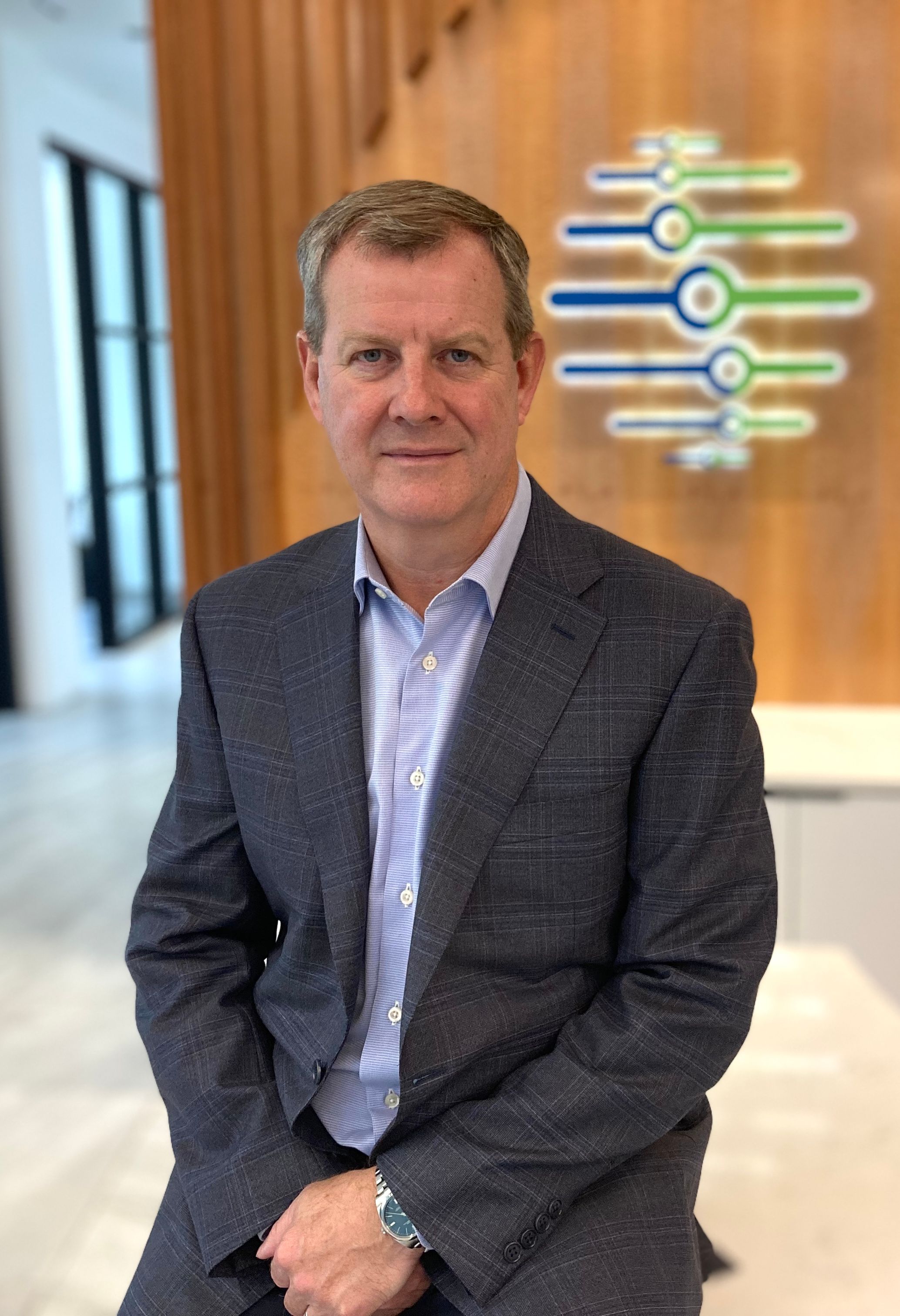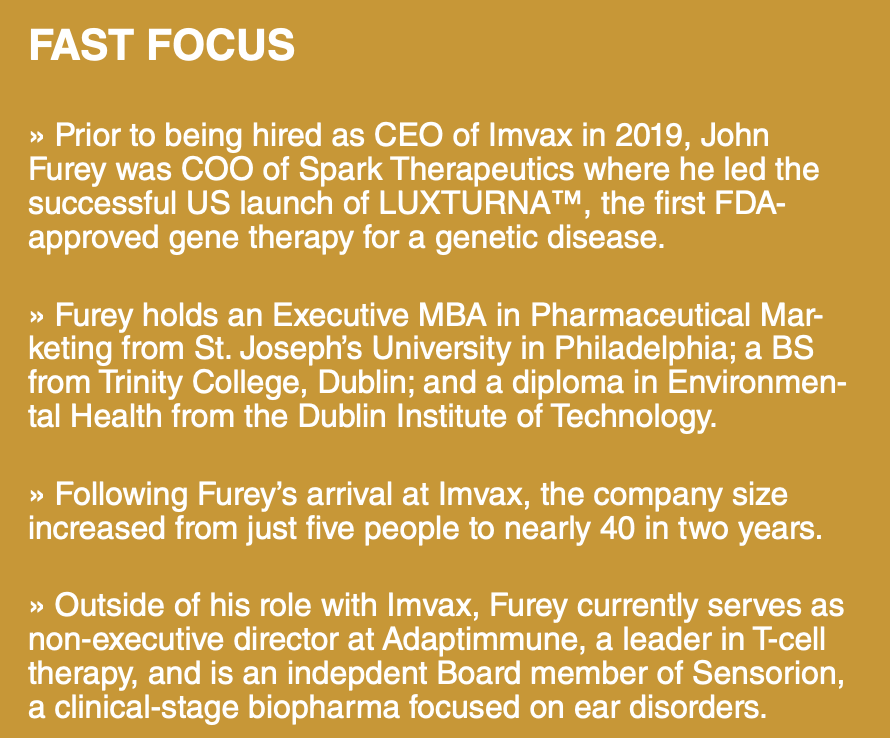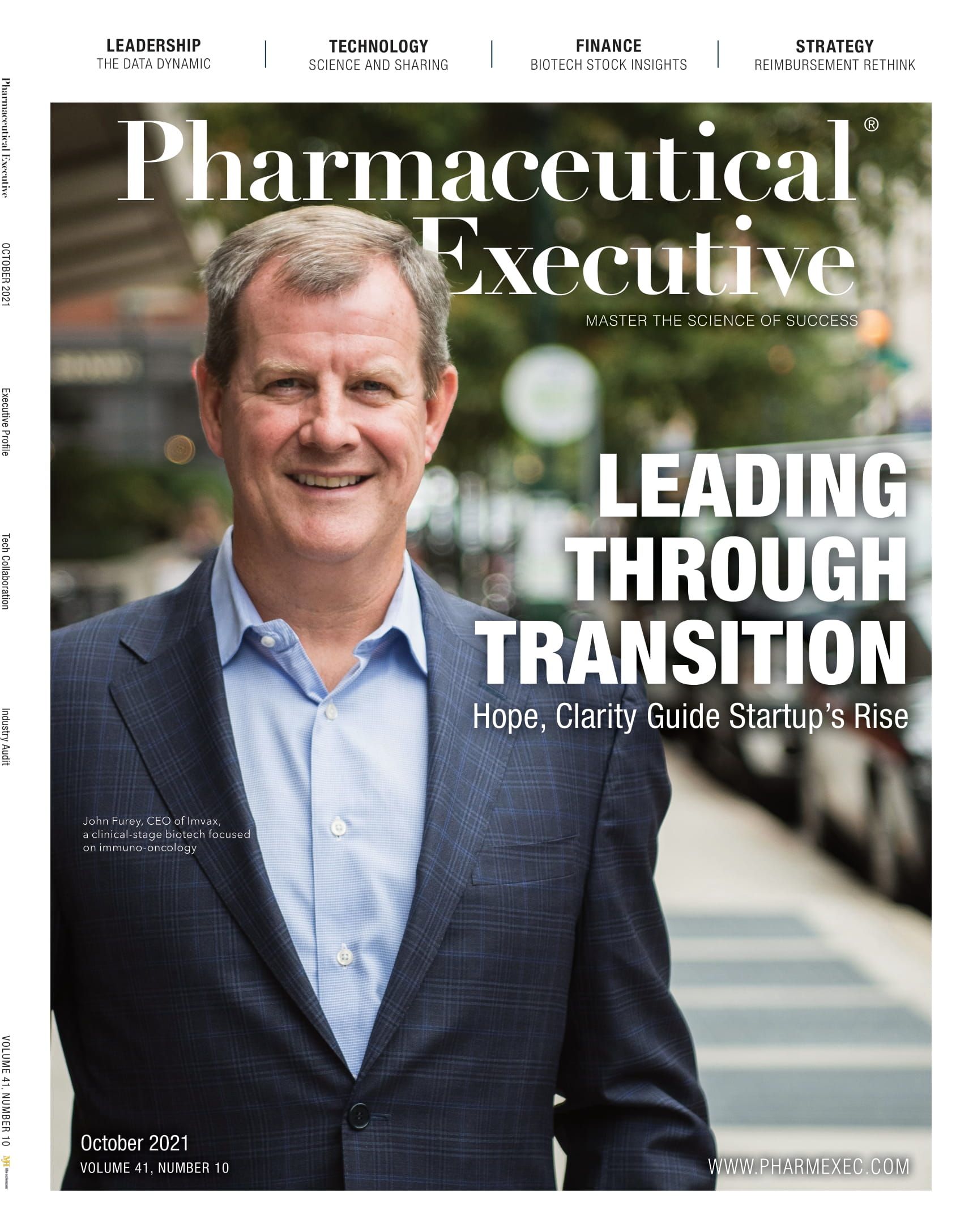- Sustainability
- DE&I
- Pandemic
- Finance
- Legal
- Technology
- Regulatory
- Global
- Pricing
- Strategy
- R&D/Clinical Trials
- Opinion
- Executive Roundtable
- Sales & Marketing
- Executive Profiles
- Leadership
- Market Access
- Patient Engagement
- Supply Chain
- Industry Trends
Leading Through Transition
Imvax CEO John Furey taps into tried-and-true powers of hope and clarity as he moves the clinical stage biotech from single program to platform company.

When you’re fueled by a passion for what you do, it’s sometimes difficult to give up getting your hands dirty. Imvax Chief Executive Officer John Furey understands that. After amassing nearly 20 years of experience in various pharma roles culminating in the chief operating officer position at Spark Therapeutics, he decided to step back and share his vast knowledge in advisory roles to various companies. But it wasn’t long before he realized his impact could be much greater in a direct operational role.
“Nearly a year into that journey, I realized that I still had an interest and a passion for another operational role,” says Furey. “I felt I could take the experiences of what I had learned in big pharma and at Spark Therapeutics, and put my energies into a project that had a meaningful impact for patients.”
In searching for that next step, Furey had two criteria: The opportunity had to have great science and great people.
Spark Chairman Steve Altschuler, who had become an investor in Imvax just months earlier, knew Furey could be an asset to the company. He invited him to an advisory role at Imvax, to help the team build the early clinical data that had been developed at Jefferson University Health System.
As Furey spent time with the Imvax team, it became clear that the data were compelling in a high unmet need in glioblastoma. In addition to the science, he developed a rapport with co-founders David Andrews, MD, who was the head of neuro-oncology at Jefferson and a pioneer of the science associated with Imvax, and Arthur Howe, chief financial officer. With both his search criteria met, Furey began discussions with Altschuler, Andrews, and Howe about joining the company in a more hands-on role as CEO and “was only too glad to join Imvax,” he says.
When Furey began in September 2019, the company consisted of just five people in a rented office in the Philadelphia neighborhood of Chestnut Hill. Two years later, it has expanded to include nearly 40 people. It has strengthened its team across key areas, including clinical, research and development, and technical operations. It has moved into its own purpose built office and laboratory space at The Curtis Center in Center City Philadelphia and is about to complete construction on a manufacturing suite there, too. Imvax has become a fully integrated biotech company in the span of two years.
Furey enjoys having day-to-day interaction with the team, patients, and various stakeholders versus working with the operational teams to strictly provide insight in an advisory role. Yet he still is able to practice his advisory muscle as a board member for Sensorion and Adaptimmune, and enjoys that balance. He’s also vice chair of the Board of Trustees for Neumann University, just outside of Philadelphia, and an Editorial Advisory Board member for Pharmaceutical Executive.
“I don’t think I would have had the same experience in an advisory role as I’ve had in the direct operational role as CEO,” says Furey. “Everything I had considered that I would like to do in one more operational role, I’m experiencing at Imvax now.”
Managing a metamorphosis
Imvax’s extraordinary growth over the past two years has brought the company to its current inflection point, and Furey has been hard at work building the necessary capabilities to get the organization to the next level. He identifies two critical areas for the company’s growth over the next two to three years.
The first is taking the Phase I investigator study and initiating Imvax’s first company-sponsored Phase II trial in glioblastoma. This will be a significant and pivotal undertaking for the company over the next 12 to 24 months.
Click to enlarge

The second is derived from Imvax developing its own laboratory and scientific capabilities. Signs are emerging through robust early preclinical data that there is potential to build out a platform in other solid tumors, deploying the same technology used for the glioblastoma study.
“We’re seeing significant signals in ovarian, liver cancer, pancreatic cancer, and we are also seeing equivalent and emerging preclinical signals in other solid tumors,” says Furey. “But what I’m feeling very positive about is that we’re able to take the technology where we have human data in GBM [glioblastoma multiforme], and now utilize it to provide an alternative for patients in a number of other solid tumors and develop a platform company.”
As Furey and Imvax navigate this journey from single program to platform company, there are many challenges. First, for any biotech company making this pivot, the operational component of running a clinical trial for the first time can be daunting. To facilitate that, Imvax is building a strong clinical operations and development team and has a solid relationship with its clinical research organization.
The second challenge is translating the early preclinical signs into investigational new drugs and to start conducting multiple Phase I trials at the same time. Furey says Imvax has “a problem of privilege” in that it’s realizing many positive early preclinical signals and hopes to be able to develop an organization that can execute on all of its opportunities. The company has recently invested resources into standardizing its chemical, manufacturing, and controls (CMC) and unique technology approach.
Finally, CEOs of early stage companies are always confronted with the issue of investment—raising money and financing the company. That’s another task Furey faces in the coming 12 months. But knowing that he and his team understand all the challenges before them and that they are putting the right resources in place gives him confidence to succeed.
A culture of hope and clarity
It’s one thing to develop and maintain a company culture, but doing that across a rapidly changing company amid the COVID-19 pandemic adds a whole new layer of complexity.
“We’ve almost tripled in size during COVID,” says Furey. “It has been a very interesting experience to grow a team and to establish those relationships that lend themselves to innovation and collaboration. As we hire people, we spend a lot of time ensuring not only their technical capabilities but their fit with the organizational culture. That has been very successful, and I’m pleased with the talent we’re bringing on board.”
When Imvax reopened its office in early July, it was a new experience for everyone. Many employees who had been working together for six to 12 months online were meeting each other for the first time in person.
“It’s been a wonderful experience to see people come together in person and now start to collaborate and innovate in person,” says Furey. “People are amazingly resourceful and flexible in these sets of circumstances.”
Whether virtual or in person, fostering an innovative and collaborative culture takes top-notch leadership skills. Furey says he learned and developed his personal management style during his days at Baxalta. His philosophy hinges on two elements: hope and clarity.
While hope relates to the vision and mission of the company, clarity involves the steps needed to achieve that goal. Working in immuno-oncology, particularly in areas of devastating disease with high unmet need, the mission of the company is clear: to help patients and bring unique therapies that can complement the existing treatment paradigm. It’s easy to motivate people to go the extra mile to help patients in that regard. But Furey says leaders also need to provide clear expectations about the milestones that signal progress. That, in addition to mission and vision, is important because it provides a tangible understanding of what progress looks like. The clarity component is equally critical in recognizing what employees’ part in that journey is and what work elements need to be accomplished to reach the milestones.
“When I joined, Imvax didn’t have a defined strategy because it was a very early startup,” says Furey. “The vision we laid out as an executive team almost 18 months ago was that by late 2021, we would be a company entering our Phase II first human trial and be a platform company across multiple tumors. Now here we are 18 months later, and that’s exactly where we are. That’s very much the hope element of what Imvax intended to achieve. The clarity was through project management and working with individual functions on their goals and objectives over the 18 months, [to figure out] the specific milestones of activity we needed to realize that ambition. I’m very pleased that those two principles have helped us make significant progress and that we’re poised now to operationalize these two vectors of growth.”
Until about six months ago, prior to Imvax receiving the preclinical signal, the company was focused on its lead asset in glioblastoma. As the company now transitions into a new phase, Furey sees his role as CEO changing, too. He will need to balance and prioritize multiple areas, and ensure that resources are provided and focused appropriately among them.
“The most important thing that I need to do is help revisit hope and clarity,” he says. “The hope is still the same—it’s to drive our lead program in glioblastoma and to be able to turn ourselves into a platform company. The clarity now is how we actually deliver on those two vectors of growth. That’s ensuring a CEO that the organization is built the right way, has the right resources, the right prioritization, and the right funding to be able to execute on both.”
Lessons to live by
Running a business requires many skills that Furey has acquired along his career journey, from a decade in business management at Pfizer, to roles at Baxter and its spinoff Baxalta, then Spark. One of the lessons he’s learned is that effective biotech leaders need to be consistent and resilient.

“Drug development is a roller coaster,” he says. “You have to be prepared for the ups and downs. It’s very important as a leader to be consistent and to be able to navigate those ups and downs, and to be able to help an organization navigate the impact of the ups and downs and keep everybody focused.”
The recent speed at which science is progressing also requires biotech leaders to be innovative and flexible in their thinking about how their technology sits in the current paradigm of science. They need to be willing to take advantage of emerging technologies either to improve their own technology or to be complementary.
“I think that’s what’s changed in the last three to five years as we’ve seen an extraordinary explosion in the cellular therapy, gene therapy, and gene editing space,” he says. “That’s where there’s been a need to adapt beyond the themes of consistency and resiliency.”
A first-rate team is essential in keeping up with a dynamic market. Throughout his career, Furey has witnessed the invaluable asset of people and hiring top talent, especially because CEOs often rely on their functional leaders to deliver on the programmatic results that are needed to keep the company moving forward. Conversely, an executive team should have great confidence in their CEO and know that they have an advocate and a coach who can aid their journey and provide the appropriate resources and advice in order to be successful. Furey says a CEO’s job is as much a coach and mentor as a strategist and visionary.
“It’s very important as a CEO that you build a great team and you rely on that team, and you provide them the necessary resources and support at the right time,” he says. “Leaders of companies now need to have a broad breadth of experience across multiple functions and different therapeutic areas to be able to be successful, given the complexity of the science and the healthcare environment we’re moving into.”
As a recent guest on the Pharmaceutical Executive podcast (https://bit.ly/2OQKppV), Furey explained how his background playing rugby has helped him develop A-teams in pharma. In rugby, there’s a place for everybody on the field; it takes a variety of physical attributes and personal characteristics blended together to create a successful team. Similarly in business, embracing differences and varying points of view helps to produce well-rounded decisions. He believes hope and clarity play an important role in bridging differences.
Furey also has learned that biotech CEOs need to be decisive. It’s unrealistic that leaders will ever have 100% of the information needed to make decisions. But there comes a point where sufficient information is available to act upon.
“Deciding in a timely manner based on a reasonable level of information is critical, given the nature of what small biotechs have to do, how they have to preserve cash, and how they have to get to critical inflection points,” says Furey. “CEOs need to be decisive, take the right advice, have sufficient data, and to some degree rely on their own experience and instinct.”
Another leadership attribute Furey has seen pay off throughout his years in biopharma is the willingness to take risks. He doesn’t recommend jumping into situations without analyzing them first. But preparing to take risks, stretching oneself, and making oneself uneasy can lead to great reward.
“I’m one of those folks that has a high propensity to take on risks; it’s just something that I’m comfortable doing,” he says. “Taking those risks has been extraordinarily helpful for me in some situations where I did very well. In other situations, I struggled and ultimately it took a bit of time for me to adapt to that new role. But I learned a lot, probably more from the experiences in which I struggled and the things where I made mistakes than from the roles where I took a risk and I was able to adapt well and quickly.”
Though the life of a startup biotech CEO doesn’t allow for much free time, Furey makes it a priority in his life. “I learned that if you have a great team, you tend to have more time,” he says. “That balance is important and it’s something I insist on throughout the organization—that people do find balance. I say to the team, this is not a sprint, this is a marathon. We’re on a journey.”
When he does get a chance to relax, he enjoys spending time with his wife and two teenage children at their home in Bryn Mawr, Pennsylvania. “They will be going off to college in a few years, so we want to spend as much time as we can together,” he says. When he’s not with his family, he likes to keep active by playing golf, running, and biking—no doubt a trait instilled in him from his sportsman days of playing rugby.
Elaine Quilici is Pharm Exec’s Senior Editor. She can be reached at equilici@mjhlifesciences.com.

